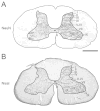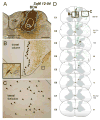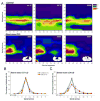Spinal cord neuron inputs to the cuneate nucleus that partially survive dorsal column lesions: A pathway that could contribute to recovery after spinal cord injury
- PMID: 25845707
- PMCID: PMC4575617
- DOI: 10.1002/cne.23783
Spinal cord neuron inputs to the cuneate nucleus that partially survive dorsal column lesions: A pathway that could contribute to recovery after spinal cord injury
Abstract
Dorsal column lesions at a high cervical level deprive the cuneate nucleus and much of the somatosensory system of its major cutaneous inputs. Over weeks of recovery, much of the hand representations in the contralateral cortex are reactivated. One possibility for such cortical reactivation by hand afferents is that preserved second-order spinal cord neurons reach the cuneate nucleus through pathways that circumvent the dorsal column lesions, contributing to cortical reactivation in an increasingly effective manner over time. To evaluate this possibility, we first injected anatomical tracers into the cuneate nucleus and plotted the distributions of labeled spinal cord neurons and fibers in control monkeys. Large numbers of neurons in the dorsal horn of the cervical spinal cord were labeled, especially ipsilaterally in lamina IV. Labeled fibers were distributed in the cuneate fasciculus and lateral funiculus. In three other squirrel monkeys, unilateral dorsal column lesions were placed at the cervical segment 4 level and tracers were injected into the ipsilateral cuneate nucleus. Two weeks later, a largely unresponsive hand representation in contralateral somatosensory cortex confirmed the effectiveness of the dorsal column lesion. However, tracer injections in the cuneate nucleus labeled only about 5% of the normal number of dorsal horn neurons, mainly in lamina IV, below the level of lesions. Our results revealed a small second-order pathway to the cuneate nucleus that survives high cervical dorsal column lesions by traveling in the lateral funiculus. This could be important for cortical reactivation by hand afferents, and recovery of hand use.
Keywords: cortical reactivation; cuneate nucleus; dorsal column lesion; lateral funiculus; second-order spinal cord pathway.
© 2015 Wiley Periodicals, Inc.
Conflict of interest statement
Figures














Similar articles
-
Second-order spinal cord pathway contributes to cortical responses after long recoveries from dorsal column injury in squirrel monkeys.Proc Natl Acad Sci U S A. 2018 Apr 17;115(16):4258-4263. doi: 10.1073/pnas.1718826115. Epub 2018 Apr 2. Proc Natl Acad Sci U S A. 2018. PMID: 29610299 Free PMC article.
-
Reorganization of somatosensory cortical areas 3b and 1 after unilateral section of dorsal columns of the spinal cord in squirrel monkeys.J Neurosci. 2011 Sep 21;31(38):13662-75. doi: 10.1523/JNEUROSCI.2366-11.2011. J Neurosci. 2011. PMID: 21940457 Free PMC article.
-
Intracortical connections are altered after long-standing deprivation of dorsal column inputs in the hand region of area 3b in squirrel monkeys.J Comp Neurol. 2016 May 1;524(7):1494-526. doi: 10.1002/cne.23921. Epub 2015 Dec 8. J Comp Neurol. 2016. PMID: 26519356 Free PMC article.
-
Cortical and subcortical plasticity in the brains of humans, primates, and rats after damage to sensory afferents in the dorsal columns of the spinal cord.Exp Neurol. 2008 Feb;209(2):407-16. doi: 10.1016/j.expneurol.2007.06.014. Epub 2007 Jul 6. Exp Neurol. 2008. PMID: 17692844 Free PMC article. Review.
-
The reactivation of somatosensory cortex and behavioral recovery after sensory loss in mature primates.Front Syst Neurosci. 2014 May 12;8:84. doi: 10.3389/fnsys.2014.00084. eCollection 2014. Front Syst Neurosci. 2014. PMID: 24860443 Free PMC article. Review.
Cited by
-
Regressive changes in sizes of somatosensory cuneate nucleus after sensory loss in primates.Proc Natl Acad Sci U S A. 2023 Mar 14;120(11):e2222076120. doi: 10.1073/pnas.2222076120. Epub 2023 Mar 6. Proc Natl Acad Sci U S A. 2023. PMID: 36877853 Free PMC article.
-
Rehabilitation Strategies after Spinal Cord Injury: Inquiry into the Mechanisms of Success and Failure.J Neurotrauma. 2017 May 15;34(10):1841-1857. doi: 10.1089/neu.2016.4577. Epub 2016 Nov 21. J Neurotrauma. 2017. PMID: 27762657 Free PMC article. Review.
-
Anatomical changes in the somatosensory system after large sensory loss predict strategies to promote functional recovery after spinal cord injury.Neural Regen Res. 2016 Apr;11(4):575-7. doi: 10.4103/1673-5374.180741. Neural Regen Res. 2016. PMID: 27212917 Free PMC article. No abstract available.
-
De novo aging-related NADPH diaphorase positive megaloneurites in the sacral spinal cord of aged dogs.Sci Rep. 2023 Dec 14;13(1):22193. doi: 10.1038/s41598-023-49594-0. Sci Rep. 2023. PMID: 38092874 Free PMC article.
-
Second-order spinal cord pathway contributes to cortical responses after long recoveries from dorsal column injury in squirrel monkeys.Proc Natl Acad Sci U S A. 2018 Apr 17;115(16):4258-4263. doi: 10.1073/pnas.1718826115. Epub 2018 Apr 2. Proc Natl Acad Sci U S A. 2018. PMID: 29610299 Free PMC article.
References
-
- Bennett GJ, Nishikawa N, Lu GW, Hoffert MJ, Dubner R. The morphology of dorsal column postsynaptic spinomedullary neurons in the cat. J Comp Neurol. 1984;224(4):568–578. - PubMed
Publication types
MeSH terms
Substances
Grants and funding
LinkOut - more resources
Full Text Sources
Other Literature Sources
Medical

